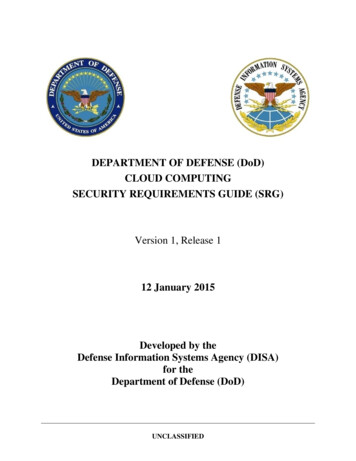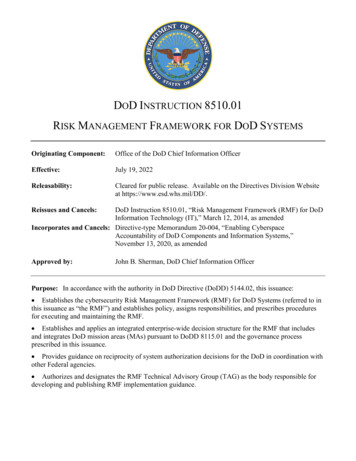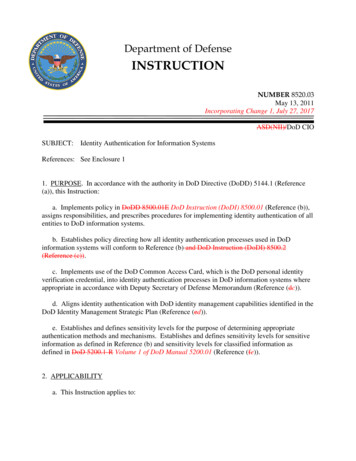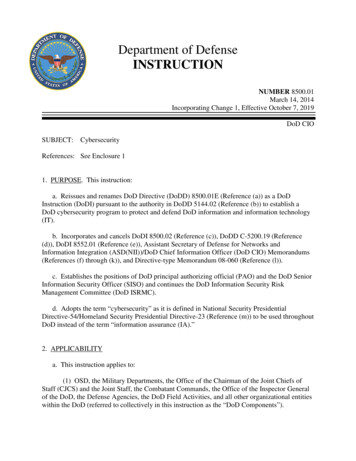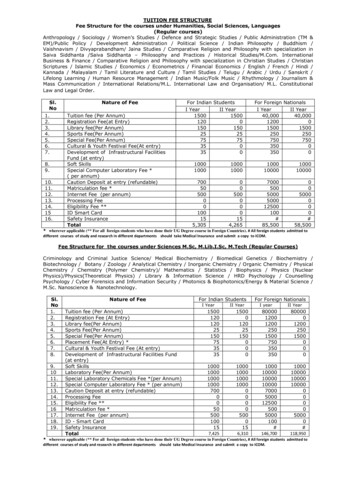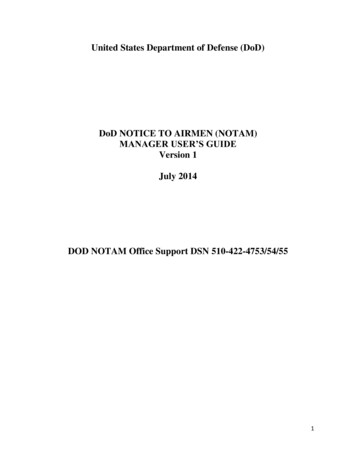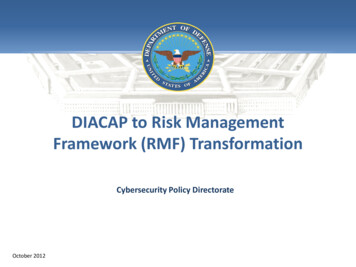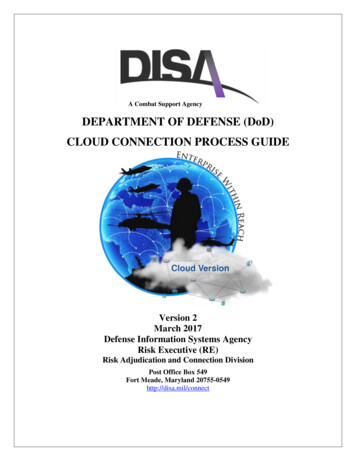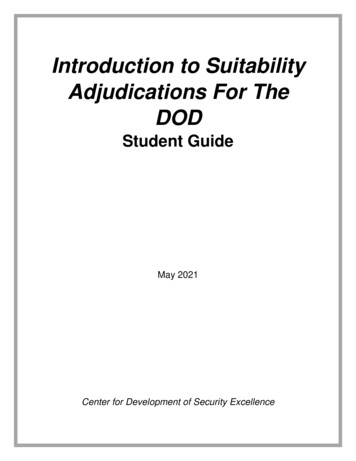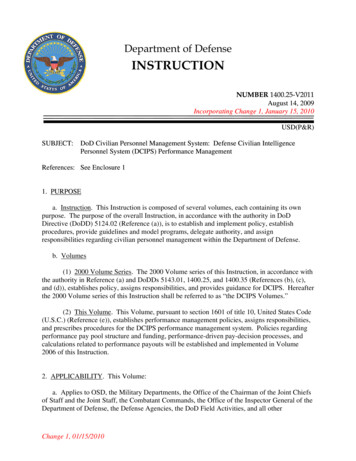
Transcription
Department of DefenseINSTRUCTIONNUMBER 1400.25-V2011August 14, 2009Incorporating Change 1, January 15, 2010USD(P&R)SUBJECT:DoD Civilian Personnel Management System: Defense Civilian IntelligencePersonnel System (DCIPS) Performance ManagementReferences: See Enclosure 11. PURPOSEa. Instruction. This Instruction is composed of several volumes, each containing its ownpurpose. The purpose of the overall Instruction, in accordance with the authority in DoDDirective (DoDD) 5124.02 (Reference (a)), is to establish and implement policy, establishprocedures, provide guidelines and model programs, delegate authority, and assignresponsibilities regarding civilian personnel management within the Department of Defense.b. Volumes(1) 2000 Volume Series. The 2000 Volume series of this Instruction, in accordance withthe authority in Reference (a) and DoDDs 5143.01, 1400.25, and 1400.35 (References (b), (c),and (d)), establishes policy, assigns responsibilities, and provides guidance for DCIPS. Hereafterthe 2000 Volume series of this Instruction shall be referred to as “the DCIPS Volumes.”(2) This Volume. This Volume, pursuant to section 1601 of title 10, United States Code(U.S.C.) (Reference (e)), establishes performance management policies, assigns responsibilities,and prescribes procedures for the DCIPS performance management system. Policies regardingperformance pay pool structure and funding, performance-driven pay-decision processes, andcalculations related to performance payouts will be established and implemented in Volume2006 of this Instruction.2. APPLICABILITY. This Volume:a. Applies to OSD, the Military Departments, the Office of the Chairman of the Joint Chiefsof Staff and the Joint Staff, the Combatant Commands, the Office of the Inspector General of theDepartment of Defense, the Defense Agencies, the DoD Field Activities, and all otherChange 1, 01/15/2010
DoDI 1400.25-V2011, August 14, 2009organizational entities in the Department of Defense (hereafter referred to collectively as the“DoD Components”).b. Applies to members of the Defense Intelligence Senior Executive System and the DefenseIntelligence Senior Level as rating officials, performance review authorities, or when performingother similar functions, unless specifically addressed in other Volumes of this Instruction.c. Does not apply to employees covered by the Federal Wage System or equivalent, nonappropriated fund employees, or foreign national employees.3. DEFINITIONS. See Glossary.4. POLICY. It is DoD policy that:a. DCIPS is an essential tool supporting the transformation of the Defense IntelligenceEnterprise called for in Under Secretary of Defense for Intelligence (USD(I)) Statement ofStrategic Intent (Reference (f)).b. The DCIPS performance management system shall:(1) Ensure the alignment of individual performance objectives to the intelligence goalsand objectives of the DoD Components with DCIPS positions.(2) Ensure ongoing feedback between employees and supervisors on progress towardaccomplishment of those objectives.(3) Provide a basis for measuring and assigning accountability for individual andorganizational performance for accomplishment of those objectives.(4) Provide a fair and equitable process for appraising and evaluating DCIPS employeeperformance within and across the DoD Components with DCIPS positions, and shall not permita forced distribution of evaluations.(5) Identify the developmental needs of DCIPS employees.(6) Be consistent with the merit system principles set forth in chapter 23 of title 5, U.S.C.(Reference (g)).5. RESPONSIBILITIESa. Under Secretary of Defense for Personnel and Readiness (USD(P&R)). The USD(P&R)shall, in conjunction with the USD(I), coordinate on the development of DCIPS performancemanagement policies and monitor their effects on DoD-wide personnel readiness.Change 1, 01/15/20102
DoDI 1400.25-V2011, August 14, 2009b. USD(I). The USD(I) shall, in conjunction with the USD(P&R), establish a commonperformance management system for DCIPS employees and positions that is in accordance withthe core requirements of the intelligence community (IC) performance management frameworkset forth in Intelligence Community Directive Number 651 (Reference (h)).c. Heads of the DoD Components With DCIPS Positions. The Heads of the DoDComponents with DCIPS positions may issue internal policy, procedures, and guidance tosupplement this Volume insofar as the supplementing issuances are in accordance withReferences (c), (d), and (e) and Volume 2001 of this Instruction.6. PROCEDURES. Enclosure 2 provides procedures for DCIPS performance management.Enclosure 3 provides specific guidance for preparing supervisory and managerial objectives.Specific performance standards that operationalize performance elements to the career field andpay level of the employee will be published in Enclosure 4.7. RELEASABILITY. UNLIMITED. This Volume is approved for public release and isavailable on the Internet from the DoD Issuances Web Site at http://www.dtic.mil/whs/directives.8. EFFECTIVE DATE. This Instruction Volume is effective 60 days from the date published onOctober 8, 2009.Gail H. McGinnDeputy Under Secretary of Defense (Plans)Performing the Duties of theUnder Secretary of Defense(Personnel and Readiness)Enclosures1. References2. Procedures3. Guidelines for Writing Performance ObjectivesGlossaryChange 1, 01/15/20103
DoDI 1400.25-V2011, August 14, 2009TABLE OF CONTENTSREFERENCES .6PROCEDURESGENERAL ROLES AND RESPONSIBILITIES .7Performance Management Performance Review Authority (PM PRA) .7Reviewing Officials .7Rating Officials .8Supervisors When Not the Rating Official .9Employees .9THE PERFORMANCE MANAGEMENT PROCESS .10PERFORMANCE PLANNING.11Elements of Performance Planning .11Annual Performance Plan .11Annual IDP .15Approval of Performance Plans .15MANAGING PERFORMANCE .15Monitoring .15Active Engagement .16Dialog and Feedback .16Minimum Period of Performance .16Adjustment of Performance Objectives During the Evaluation Period .17Adding Performance Objectives .17Mandatory Midpoint Performance Review .17DEVELOPING PERFORMANCE.18Employee Development .18Monitoring Progress Against the IDP .18Addressing Needs for Performance Improvement .19END-OF-YEAR PERFORMANCE EVALUATION .19Rating Performance Objectives .20Rating Performance Elements.22Performance Evaluation of Record .23Reviewing Official’s Evaluation of Performance .24PM PRA Review of Performance Evaluations of Record .25Communicating the Performance Record to the Employee.25INTERIM PERIODS OF PERFORMANCE DURING THE PERFORMANCEEVALUATION PERIOD .25Closeout Performance Evaluation.26Interim or Temporary Assignment Report of Performance .26SPECIAL CIRCUMSTANCES .27Employees Absent to Perform Military Service .27Employees Absent on Workers’ Compensation .27Employees Absent Due to Other Special Circumstances .27Change 1, 01/15/20104CONTENTS
DoDI 1400.25-V2011, August 14, 2009Administrative Error .27CHALLENGING THE EVALUATION OF RECORD .27Alternative Dispute Resolution .28Relationship to Compensation .28Procedures for Administrative Reconsideration .28GUIDELINES FOR WRITING PERFORMANCE OBJECTIVES.31OVERVIEW .31THE SMART OBJECTIVE.31WRITING SMART OBJECTIVES FOR EMPLOYEES.32Performance Objectives are not Duty Statements .32Performance Objectives are Specific .32Performance Objectives are Measurable .32Performance Objectives are Achievable .33Performance Objectives are Relevant .33Performance Objectives are Timely or Time-Bounded .33WRITING PERFORMANCE OBJECTIVES FOR SUPERVISORS AND MANAGERS.33GLOSSARY .35TABLES1. Performance Objectives and Element Rating Descriptors .212. Converting Average Rating to Evaluation of Record .23Change 1, 01/15/20105CONTENTS
DoDI 1400.25-V2011, August 14, 2009ENCLOSURE 1REFERENCES(a)(b)(c)(d)(e)(f)(g)(h)(i)DoD Directive 5124.02, “Under Secretary of Defense for Personnel and ReadinessUSD(P&R)),” June 23, 2008DoD Directive 5143.01, “Under Secretary of Defense for Intelligence (USD(I)),”November 23, 2005DoD Directive 1400.25, “DoD Civilian Personnel Management System,” November 25,1996DoD Directive 1400.35, “Defense Civilian Intelligence Personnel System (DCIPS),”September 24, 2007Section 1601 of title 10, United States CodeUnder Secretary of Defense for Intelligence Statement of Strategic Intent, “Strategic Intentfor the Defense Intelligence Enterprise,” August 2007 1Chapter 23 of title 5, United States CodeIntelligence Community Directive Number 651, “Human Capital PerformanceManagement for the Intelligence Community Civilian Workforce,” November 28, 2007Director of National Intelligence Strategy, “The National Intelligence Strategy of theUnited States of America,” October 2005 21Copies are available to authorized users athttps://usdi.dtic.mil/usdi docs/keyref/dcs/keydocs/USDI Statement of Strategic Intent 10112007.pdf2Available through the Internet at Change 1, 01/15/20106ENCLOSURE 1
DoDI 1400.25-V2011, August 14, 2009ENCLOSURE 2PROCEDURES1. GENERAL ROLES AND RESPONSIBILITIES. Performance management has one primarypurpose: to achieve organizational results and mission objectives through the effectivemanagement of individual and organizational performance. To achieve that purpose,performance management shall be a priority for all Defense Intelligence executives, managers,supervisors, and employees. The performance expectations of organizations and their seniorleaders shall be linked to the Director of National Intelligence Strategy (Reference (i), hereafterreferred to as the “National Intelligence Strategy” (NIS)) and applicable strategies of theDepartment of Defense and the DoD Components with DCIPS positions. Performanceexpectations shall cascade from the senior levels of the organization through subordinatemanagers and supervisors to individual employees. Successful performance managementrequires commitment to performance planning, measurement, and management practices. Allparticipants in the performance management process must invest adequate time and effortthroughout the evaluation period to ensure performance management is effective.a. Performance Management Performance Review Authority (PM PRA). The PM PRA isresponsible for:(1) Oversight of performance evaluations conducted under his or her purview to ensurethe consistency of DCIPS performance management practices within the DoD Components withDCIPS positions.(2) Ensuring compliance with merit system principles and prevention of conflicts ofinterest in the establishment and operation of pay pools.(3) Final independent review of employee evaluation of record when challenged by anemployee. (See section 9 of this enclosure.)b. Reviewing Officials. Reviewing officials are the approving official for each individualevaluation of record within their purview. Reviewing officials are responsible and shall be heldaccountable for ensuring accuracy of performance management within the subordinateorganizations and units for which they are responsible. This includes but is not limited toensuring that:(1) Performance and individual development plans (IDPs) are in place in accordancewithin established timelines for all employees.(2) Subordinate rating officials and supervisors (when the supervisor is not the ratingofficial) are trained in their roles. (See paragraphs 1.d. and 1.e. of this enclosure for ratingofficial and supervisor responsibilities).Change 1, 01/15/20107ENCLOSURE 2
DoDI 1400.25-V2011, August 14, 2009(3) Subordinate rating officials are providing performance feedback throughout theevaluation period and rating officials have documented at least one midpoint performance reviewfeedback session with each employee.(4) Subordinate rating officials, when not the immediate supervisor of employees forwhom they are the rating official, are maintaining ongoing dialog with the immediate supervisorsof those employees regarding employee performance.(5) All evaluations of record within subordinate organizations and units are completedwithin established timelines.(6) Performance standards are consistently applied among those rating officials forwhom they are the reviewing official.(7) Subordinate rating officials are executing their responsibilities consistent with meritsystem principles.c. Rating Officials. Rating officials are responsible and shall be held accountable foreffectively managing the performance of assigned employees. This includes but is not limitedto:(1) Executing the requirements of this Volume in accordance with the merit systemprinciples set forth in Reference (g).(2) Ensuring employees are trained in the performance management system.(3) Developing and communicating performance objectives and expectations within theestablished timelines and holding employees accountable for accomplishing them.(4) Preparing jointly with employees, to the extent practicable, development objectivesfor the performance year and recording them in an IDP.(5) Aligning performance objectives and employee development with organizationalgoals and objectives.(6) Discussing with employees the relevance of performance elements to individualperformance objectives.(7) Providing employees meaningful, constructive, and candid feedback relative toprogress against performance expectations including at least one documented midpoint review.(8) Ensuring employees are aware of the requirement to document theiraccomplishments at the end of the evaluation period.(9) Fostering and rewarding excellent performance.Change 1, 01/15/20108ENCLOSURE 2
DoDI 1400.25-V2011, August 14, 2009(10) Addressing poor performance.(11) Making meaningful distinctions among employees based on performance andcontribution.(12) Completing closeout and interim performance evaluations as required withinestablished timelines.(13) Ensuring eligible employees are assigned an evaluation of record as prescribed bythis Volume.(14) Collaborating with reviewing officials to complete evaluations of record.d. Supervisors When Not the Rating Official. Supervisors normally will be the ratingofficial for employees under their direct supervision. However, in unusual circumstances inwhich rating official responsibilities are assigned to an official in the chain of supervision abovethe immediate supervisor, the supervisor shall be responsible and accountable for collaboratingwith the rating official in his or her performance management responsibilities. This includes theresponsibility for:(1) Ensuring he or she maintains ongoing dialog with the rating official regarding theemployee’s performance during the evaluation period.(2) Participating with the rating official in the completion of the employee’s evaluationof record.(3) Participating with the rating official in the completion of closeout or interimperformance evaluations on employees under their supervision for whom they are not the ratingofficial.e. Employees. Employees are accountable for:(1) Engaging in dialog with rating officials and supervisors (when the supervisor is notthe rating official) to develop performance objectives and their IDP at the beginning of eachevaluation period.(2) Identifying and recording their accomplishments and results throughout theevaluation period.(3) Participating in midpoint performance reviews and end-of-year performanceevaluation discussions with their rating officials.(4) Preparing their end-of-year accomplishments as input to their annual performanceevaluations.Change 1, 01/15/20109ENCLOSURE 2
DoDI 1400.25-V2011, August 14, 2009(5) Understanding the link between their performance objectives and the organizationalmission and goals.(6) Accepting accountability for their actions.2. THE PERFORMANCE MANAGEMENT PROCESSa. The DCIPS performance management process consists of three distinct phases:performance planning, managing performance throughout the evaluation period, and evaluationof performance at the end of the performance evaluation period. The standard evaluation periodfor DCIPS runs from October 1 through September 30 of each year unless an exception has beengranted by the USD(I). The performance evaluation period officially begins on October 1 ofeach year with the performance planning process. During the performance planning process,rating officials (in collaboration with the supervisor when the supervisor is not the rating official)and employees shall engage in dialog to establish performance objectives that they shall beexpected to accomplish during the performance evaluation period. The objectives set theexpectations for “what” specifically each employee is expected to accomplish during the comingyear. The rating official and employee planning process shall also include discussion of the sixbehaviorally-based DCIPS performance elements (the “how” of performance) described insubparagraph 3.b.(2)(b) of this enclosure. These six elements are evaluated independently of theperformance objectives.b. Rating officials (in collaboration with the supervisor when the supervisor is not the ratingofficial) and employees shall engage in continuing dialog throughout the performance evaluationperiod to manage performance. Dialog shall focus on progress against performance objectivesand events or obstacles that may occur during the evaluation period that could prevent successfulachievement of those objectives. Any resulting modifications or formal changes in theobjectives against which the employee is working should be documented at the time they areidentified up to the final 90 days of the evaluation period. Additional dialog should also beongoing throughout the evaluation period, focused on the developmental needs of the employeeto increase effectiveness and on other factors within the control of the employee or supervisorthat may contribute to the success of the employee and the organization. At least once during theperformance evaluation period, generally at the midpoint of the period, the supervisor (inconjunction with the rating official when the supervisor is not the rating official) shall documentformally the performance discussion with the employee.c. At the end of the performance evaluation period, the employee shall document his or heraccomplishments and submit them to the rating official (through the supervisor when thesupervisor is not the rating official) as an element of the formal evaluation of performance for theyear. The formal evaluation of the employee’s performance shall include an evaluation of theextent to which the employee achieved his or her performance objectives, an evaluation of howthe employee performed against the six performance elements that contribute to success, and anoverall summary evaluation of record. The evaluation of the employee’s performance againstperformance elements shall consider the extent to which the employee fulfilled his or heraccountabilities under paragraph 1.f. of this enclosure.Change 1, 01/15/201010ENCLOSURE 2
DoDI 1400.25-V2011, August 14, 20093. PERFORMANCE PLANNINGa. Elements of Performance Planning. Performance planning shall include dialog betweenthe rating official (in collaboration with the supervisor when the supervisor is not the ratingofficial) and the employee to:(1) Establish performance objectives, generally three to six, that are aligned to the goalsand objectives of the NIS, the Department of Defense, and the employee’s organization and thatset specific performance targets for the individual.(2) Ensure employee understanding of the relationship between the performanceelements discussed in subparagraph 3.b.(2)(b) of this enclosure and the performance objectives.(3) Establish specific developmental objectives in an IDP that are keyed to theattainment of competencies and skills critical to success in the job and the employee’s careerfield, but that may not have been required qualifications for selection to the position.(4) Establish the criteria against which the employee’s success shall be measured.b. Annual Performance Plan(1) Purpose and Requirements. The annual performance plan shall be prepared as arecord of the performance planning process in accordance with these requirements:(a) Every eligible employee shall be issued a written performance plan and IDP bythe rating official (in collaboration with the supervisor when the supervisor is not the ratingofficial) at the beginning of the annual evaluation period each year.(b) Employees assigned to a position at the beginning of the evaluation period shallhave approved performance plans and IDPs not later than 30 days after the beginning of theevaluation period.(c) Employees newly-appointed or newly-assigned to a position shall have approvedperformance plans and IDPs not later than 30 days from the date of appointment to the position.(d) Rating officials (in collaboration with the supervisor when the supervisor is notthe rating official) shall establish performance plans in consultation with their employees.(e) Reviewing officials shall review and approve each performance plan to ensure itsconsistency with organizational goals and objectives; appropriateness to employee experience,developmental needs, and work level; and equity with other plans within the purview of thereviewing official.(2) Performance Objectives and Elements. The performance plan shall address:Change 1, 01/15/201011ENCLOSURE 2
DoDI 1400.25-V2011, August 14, 2009(a) Performance Objectives. Each performance plan generally should include threeto six performance objectives aligned with the objectives of the NIS, the Department of Defense,and the employee’s organization.1. Non-Supervisory Performance Objectivesa. Each non-supervisory employee shall be assigned performance objectivesappropriate to the employee’s pay band and career or occupational category. Each objectiveshall be derived from organizational goals and objectives and shall be a critical element of theemployee’s job. Each objective shall also be structured such that it is specific, measurable,achievable, relevant, and time-bounded (SMART) in accordance with guidance provided inEnclosure 3.b. Each performance objective shall include specific information on howachievement of the objective shall be measured.2. Supervisory and/or Managerial Performance Objectivesa. Supervisors and managers under a DCIPS performance plan areaccountable for achieving work results through subordinates. Therefore, performance objectivesfor supervisors and managers shall be prepared to reflect their progressively more demandingleadership role. Individual objectives shall be appropriate to the level of supervisory ormanagerial responsibility and pay. Objectives for the first-level supervisor should reflectresponsibility for leading and managing the work and professional development of his or herdirect report employees. Objectives for second- or higher-level managers should reflect theirresponsibility for setting the goals and direction of the unit, acquiring resources necessary forsuccess, engaging in ongoing evaluation of results, and implementing necessary coursecorrections in pursuit of results. Enclosure 3 provides specific guidance for preparingsupervisory and managerial objectives.b. Rating officials shall provide subordinate supervisors and managersspecific information on how achievement of objectives will be measured.(b) Performance Elements for All Employees. All employees, both non-supervisoryand those holding supervisory or managerial positions, shall be rated against the sixbehaviorally-based performance elements described in subparagraphs 3.b.(2)(b)1. through3.b.(2)(b)6. of this enclosure. For supervisors and managers, the focus of each performanceelement shifts from the behaviors inherent in non-supervisory positions to those required ofsupervisors and managers responsible for leading the work of the organization. Performanceexpectations, even if not stated in a specific performance objective, include certain behavioralexpectations that are related to an employee’s conduct in the workplace and his or her approachto accomplishing specific performance objectives, including carrying out performancemanagement responsibilities of this Volume. These aspects of an employee’s performance arecaptured in the performance elements against which all employees shall be rated. Enclosure 4 tothis Volume will contain specific performance standards that operationalize performanceelements to the career field and pay level of the employee.Change 1, 01/15/201012ENCLOSURE 2
DoDI 1400.25-V2011, August 14, 20091. Accountability for Results. DCIPS employees are expected to takeresponsibility for their work, setting and/or meeting priorities, and organizing and utilizing timeand resources efficiently and effectively to achieve the desired results consistent with theirorganization’s goals and objectives. In addition, supervisors and managers are expected to usethese same skills to accept responsibility for and achieve results through the actions andcontributions of their subordinates and their organization as a whole.2. Communication. DCIPS employees are expected to effectively comprehendand convey information with and from others in writing, reading, listening, and verbal and nonverbal action. Employees are expected to use a variety of media in communicating and makingpresentations appropriate to the audience. In addition, DoD IC supervisors and managers areexpected to use effective communication skills to build cohesive work teams, develop ind
Enclosure 2 provides procedures for DCIPS performance management. Enclosure 3 provides specific guidance for preparing supervisory and managerial objectives. Specific performance standards that operationalize performance elements to the career field and pay level of the employee will be published in Enclosure 4. 7. RELEASABILITY. UNLIMITED.
